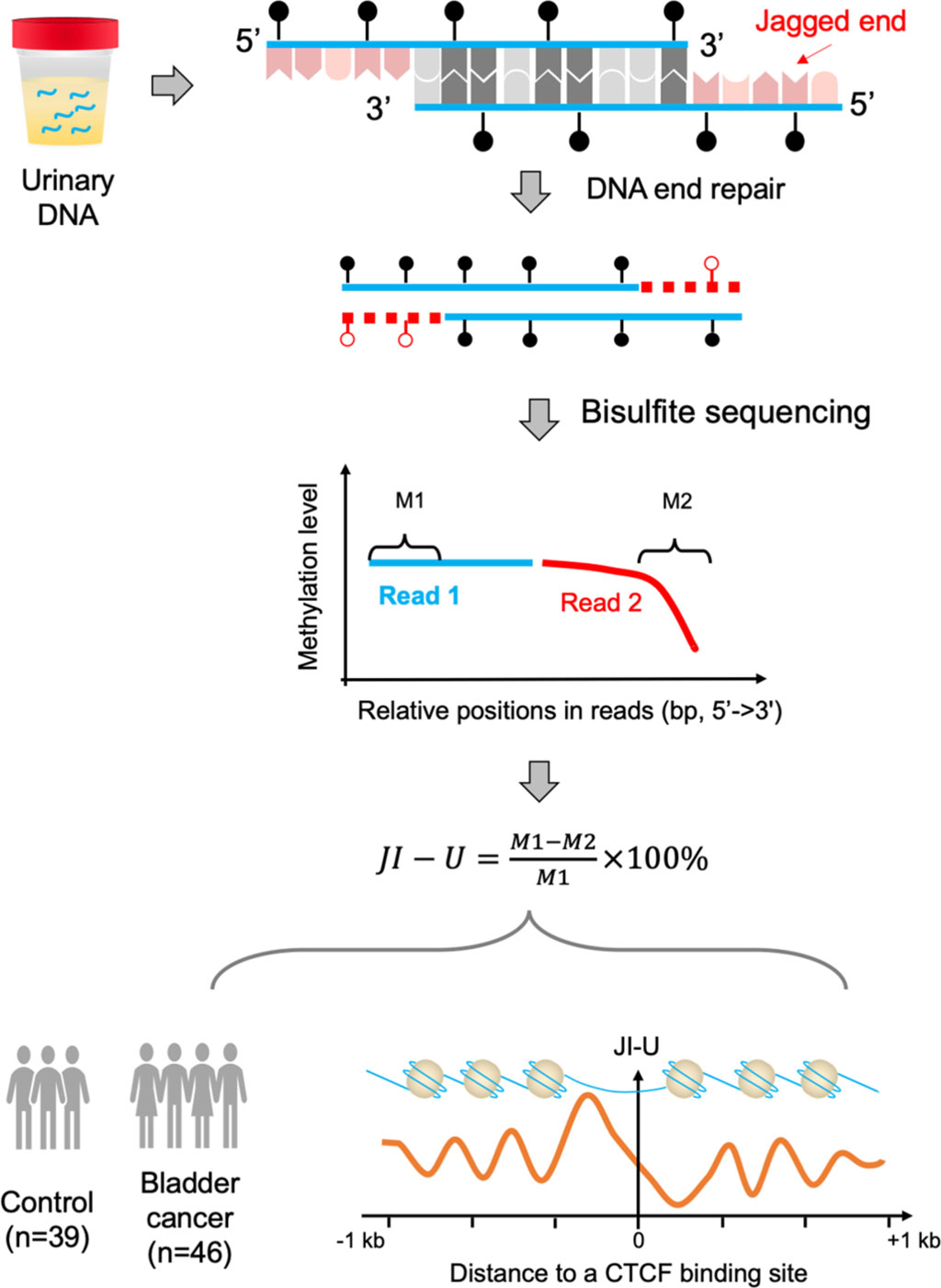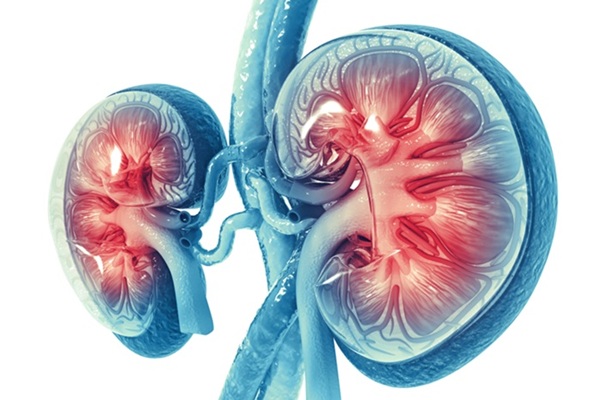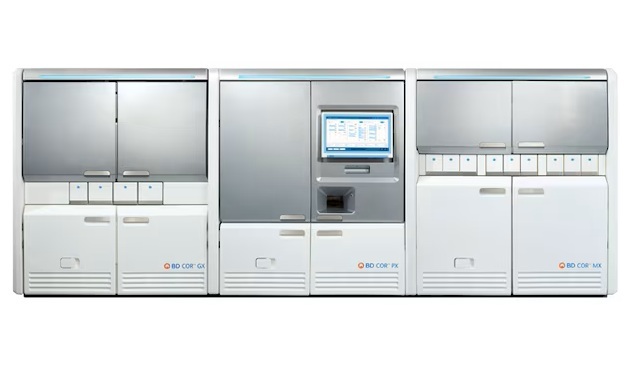Jagged Ends of Urinary Cell-Free DNA Assessed in Bladder Cancer Detection
|
By LabMedica International staff writers Posted on 24 May 2021 |

Image: Schematic of workflow for urinary DNA jagged end analysis. Urinary DNA was subjected to an end-repair process; JI-U = jagged index–unmethylated (Photo courtesy of The Chinese University of Hong Kong)
Bladder cancer is where a growth of abnormal tissue, known as a tumor, develops in the bladder lining. In some cases, the tumor spreads into the bladder muscle. The most common symptom of bladder cancer is blood in the urine, which is usually painless.
Cell-free DNA (cfDNA) molecules in plasma consist of fragments of DNA. Much interest has been focused recently on the fragmentation patterns of such DNA molecules. The fragment sizes and ends, for example, display nucleosomal features in relation to the tissues of origin. When compared with plasma DNA, urinary cfDNA molecules exhibit a different size profile; therefore, urinary DNA molecules are much more fragmented than plasma DNA.
Medical Scientists at The Chinese University of Hong Kong (Shatin, Hong Kong, China) and their colleagues obtained bisulfite sequencing data of urinary DNA from a previous study, including 46 patients with bladder cancer, all of whom were urothelial cell carcinoma, and 39 control participants with hematuria, but without detectable bladder cancer. Among patients with bladder cancer, 37 had non–muscle-invasive bladder cancer and nine patients with muscle-invasive bladder cancer.
Urinary cfDNA was extracted using the Wizard Plus Minipreps DNA Purification System (Promega, Madison, WI, USA) with the addition of guanidine thiocyanate to urine before mixing with resin. DNA libraries were sequenced using the Illumina HiSeq 2500 or NextSeq 500 with a 41 bp × 2 paired-end sequencing protocol (Illumina, San Diego, CA, USA). Incorporation of unmethylated cytosines during the repair of the jagged ends lowered the apparent methylation levels measured by bisulfite sequencing and were used to calculate a jagged end index. This approach is called jagged end analysis by sequencing.
The investigators reported that the jagged end index of urinary cfDNA was higher than that of plasma DNA. The jagged end index profile of plasma DNA displayed several strongly oscillating major peaks at intervals of approximately 165 bp (i.e., nucleosome size) and weakly oscillating minor peaks with periodicities of approximately 10 bp. In contrast, the urinary DNA jagged end index profile showed weakly oscillating major peaks, but strongly oscillating minor peaks. The jagged end index was generally higher in nucleosomal linker DNA regions. The 46 Patients with bladder cancer had lower jagged end indexed of urinary DNA than 39 participants without bladder cancer. The area under the curve for differentiating between patients with and without bladder cancer was 0.83.
The authors concluded that jagged ends represent a property of urinary cfDNA. The generation of jagged ends might be related to nucleosomal structures, with enrichment in linker DNA regions. Jagged ends of urinary DNA could potentially serve as a new biomarker for bladder cancer detection. The study was published in the April, 2021 issue of the journal Clinical Chemistry.
Related Links:
The Chinese University of Hong Kong
Promega
Illumina
Cell-free DNA (cfDNA) molecules in plasma consist of fragments of DNA. Much interest has been focused recently on the fragmentation patterns of such DNA molecules. The fragment sizes and ends, for example, display nucleosomal features in relation to the tissues of origin. When compared with plasma DNA, urinary cfDNA molecules exhibit a different size profile; therefore, urinary DNA molecules are much more fragmented than plasma DNA.
Medical Scientists at The Chinese University of Hong Kong (Shatin, Hong Kong, China) and their colleagues obtained bisulfite sequencing data of urinary DNA from a previous study, including 46 patients with bladder cancer, all of whom were urothelial cell carcinoma, and 39 control participants with hematuria, but without detectable bladder cancer. Among patients with bladder cancer, 37 had non–muscle-invasive bladder cancer and nine patients with muscle-invasive bladder cancer.
Urinary cfDNA was extracted using the Wizard Plus Minipreps DNA Purification System (Promega, Madison, WI, USA) with the addition of guanidine thiocyanate to urine before mixing with resin. DNA libraries were sequenced using the Illumina HiSeq 2500 or NextSeq 500 with a 41 bp × 2 paired-end sequencing protocol (Illumina, San Diego, CA, USA). Incorporation of unmethylated cytosines during the repair of the jagged ends lowered the apparent methylation levels measured by bisulfite sequencing and were used to calculate a jagged end index. This approach is called jagged end analysis by sequencing.
The investigators reported that the jagged end index of urinary cfDNA was higher than that of plasma DNA. The jagged end index profile of plasma DNA displayed several strongly oscillating major peaks at intervals of approximately 165 bp (i.e., nucleosome size) and weakly oscillating minor peaks with periodicities of approximately 10 bp. In contrast, the urinary DNA jagged end index profile showed weakly oscillating major peaks, but strongly oscillating minor peaks. The jagged end index was generally higher in nucleosomal linker DNA regions. The 46 Patients with bladder cancer had lower jagged end indexed of urinary DNA than 39 participants without bladder cancer. The area under the curve for differentiating between patients with and without bladder cancer was 0.83.
The authors concluded that jagged ends represent a property of urinary cfDNA. The generation of jagged ends might be related to nucleosomal structures, with enrichment in linker DNA regions. Jagged ends of urinary DNA could potentially serve as a new biomarker for bladder cancer detection. The study was published in the April, 2021 issue of the journal Clinical Chemistry.
Related Links:
The Chinese University of Hong Kong
Promega
Illumina
Latest Pathology News
- New Molecular Analysis Tool to Improve Disease Diagnosis
- Tears Offer Noninvasive Alternative for Diagnosing Neurodegenerative Diseases
- AI-Powered Method Combines Blood Data to Accurately Measure Biological Age
- AI Tool Detects Cancer in Blood Samples In 10 Minutes
- AI Pathology Analysis System Delivers Comprehensive Cancer Diagnosis
- AI Improves Cervical Cancer Screening in Low-Resource Settings
- New Multi-Omics Tool Illuminates Cancer Progression
- New Technique Detects Genetic Mutations in Brain Tumors During Surgery within 25 Minutes
- New Imaging Tech to Improve Diagnosis and Treatment of Skin Cancers
- Serially Testing Brain Tumor Samples Reveals Treatment Response in Glioblastoma Patients
- High-Accuracy Tumor Detection Method Offers Real-Time Surgical Guidance
- AI Tool Detects Hidden Warning Signs of Disease Inside Single Cells
- Automated Tool Detects Early Warning Signs of Breast Cancer
- New Software Tool Improves Analysis of Complex Spatial Data from Tissues
- AI Tool Helps Surgeons Distinguish Aggressive Glioblastoma from Other Brain Cancers in Real-Time
- New Tool Could Revolutionize Acute Leukemia Diagnosis
Channels
Clinical Chemistry
view channel
VOCs Show Promise for Early Multi-Cancer Detection
Early cancer detection is critical to improving survival rates, but most current screening methods focus on individual cancer types and often involve invasive procedures. This makes it difficult to identify... Read more
Portable Raman Spectroscopy Offers Cost-Effective Kidney Disease Diagnosis at POC
Kidney disease is typically diagnosed through blood or urine tests, often when patients present with symptoms such as blood in urine, shortness of breath, or weight loss. While these tests are common,... Read moreHematology
view channel
ADLM’s New Coagulation Testing Guidance to Improve Care for Patients on Blood Thinners
Direct oral anticoagulants (DOACs) are one of the most common types of blood thinners. Patients take them to prevent a host of complications that could arise from blood clotting, including stroke, deep... Read more
Viscoelastic Testing Could Improve Treatment of Maternal Hemorrhage
Postpartum hemorrhage, severe bleeding after childbirth, remains one of the leading causes of maternal mortality worldwide, yet many of these deaths are preventable. Standard care can be hindered by delays... Read more
Pioneering Model Measures Radiation Exposure in Blood for Precise Cancer Treatments
Scientists have long focused on protecting organs near tumors during radiotherapy, but blood — a vital, circulating tissue — has largely been excluded from dose calculations. Each blood cell passing through... Read moreImmunology
view channel
Blood-Based Liquid Biopsy Model Analyzes Immunotherapy Effectiveness
Immunotherapy has revolutionized cancer care by harnessing the immune system to fight tumors, yet predicting who will benefit remains a major challenge. Many patients undergo costly and taxing treatment... Read more
Signature Genes Predict T-Cell Expansion in Cancer Immunotherapy
Modern cancer immunotherapies rely on the ability of CD8⁺ T cells to rapidly multiply within tumors, generating the immune force needed to eliminate cancer cells. However, the biological triggers behind... Read moreMicrobiology
view channel
High-Throughput Enteric Panels Detect Multiple GI Bacterial Infections from Single Stool Swab Sample
Gastrointestinal (GI) infections are among the most common causes of illness worldwide, leading to over 1.7 million deaths annually and placing a heavy burden on healthcare systems. Conventional diagnostic... Read more
Fast Noninvasive Bedside Test Uses Sugar Fingerprint to Detect Fungal Infections
Candida bloodstream infections are a growing global health threat, causing an estimated 6 million cases and 3.8 million deaths annually. Hospitals are particularly vulnerable, as weakened patients after... Read morePathology
view channel
New Molecular Analysis Tool to Improve Disease Diagnosis
Accurately distinguishing between similar biomolecules such as proteins is vital for biomedical research and diagnostics, yet existing analytical tools often fail to detect subtle structural or compositional... Read more
Tears Offer Noninvasive Alternative for Diagnosing Neurodegenerative Diseases
Diagnosing and monitoring eye and neurodegenerative diseases often requires invasive procedures to access ocular fluids. Ocular fluids like aqueous humor and vitreous humor contain valuable molecular information... Read moreTechnology
view channel
Cell-Sorting Device Uses Electromagnetic Levitation to Precisely Direct Cell Movement
Sorting different cell types—such as cancerous versus healthy or live versus dead cells—is a critical task in biology and medicine. However, conventional methods often require labeling, chemical exposure,... Read more
Embedded GPU Platform Enables Rapid Blood Profiling for POC Diagnostics
Blood tests remain a cornerstone of medical diagnostics, but traditional imaging and analysis methods can be slow, costly, and reliant on dyes or contrast agents. Now, scientists have developed a real-time,... Read moreIndustry
view channel
Qiagen Acquires Single-Cell Omics Firm Parse Biosciences
QIAGEN (Venlo, Netherlands) has entered into a definitive agreement to fully acquire Parse Biosciences (Seattle, WA, USA), a provider of scalable, instrument-free solutions for single-cell research.... Read more
Puritan Medical Products Showcasing Innovation at AMP2025 in Boston
Puritan Medical Products (Guilford, ME, USA), the world’s most trusted manufacturer of swabs and specimen collection devices, is set to exhibit at AMP2025 in Boston, Massachusetts, from November 11–15.... Read more
Advanced Instruments Merged Under Nova Biomedical Name
Advanced Instruments (Norwood, MA, USA) and Nova Biomedical (Waltham, MA, USA) are now officially doing business under a single, unified brand. This transformation is expected to deliver greater value... Read more






















